|
|
|
Sort Order |
|
|
|
Items / Page
|
|
|
|
|
|
|
| Srl | Item |
| 1 |
ID:
191354
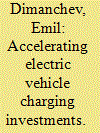

|
|
|
|
|
| Summary/Abstract |
Replacing conventional cars and trucks with battery electric vehicles requires a rapid expansion of fast-charging infrastructure. However, private sector charging infrastructure investments are delayed by unfavorable project economics and uncertainty in future demand. Prior research has addressed the former using standard net present value (NPV) methods, but neglected the latter. To address this gap, this paper introduces a real options model of charging investments, which quantifies the option value of delaying investment under uncertainty. We use this model to assess the implications of optionality in a representative case. Our analysis provides indicative estimates of how investment timing is impacted by alternative policy options: grants, long-term contracts, demand charge re-design, and Zero Emission Vehicle standards. We estimate that if grant subsidies are informed by a traditional NPV analysis, firms would delay investing by more than 5 years. Perhaps surprisingly, even low levels of risk incentivize long delays. We find that policies targeting optionality are substantially more cost-effective than the traditionally used grants. Specifically, we calculate that long-term contracts for differences can trigger immediate investments at a cost 68% lower than grants. A simpler but relatively cost-effective alternative is to introduce a phase-out schedule for grants to discourage investment delays.
|
|
|
|
|
|
|
|
|
|
|
|
|
|
|
|
| 2 |
ID:
168650
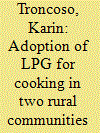

|
|
|
|
|
| Summary/Abstract |
In 2011, a government initiative provided Liquefied Petroleum Gas (LPG) stoves and cylinders to almost 1000 rural families in Chiapas, Mexico. In 2017, the Pan-American Health Organization (PAHO) conducted an evaluation of cooking practices among the beneficiaries of these stoves.
|
|
|
|
|
|
|
|
|
|
|
|
|
|
|
|
| 3 |
ID:
149944


|
|
|
|
|
| Summary/Abstract |
As atmospheric CO2 continues to rise above 450 PPM, policymakers struggle with uncertainty concerning predictors of citizen support for environmental energy policies (EEPs) and preferences for their design, topics which have received limited attention in empirical literature. We present an original model of policy support based on citizens’ affinity-to-commons: pathways by which individuals enjoy natural public goods that in turn shape preferences between alternative policy mechanisms. We evaluate this model using a survey of southern California electricity customers, with results indicating the model's utility in predicting public support of EEP. Stronger community ties are associated with preferences for “pull”-type subsidies, whereas stronger connections to natural commons are linked to support for both “pull” and “push”-type sanctions. Findings have implications for coalition building as advocates may engender support for green energy policy by framing sanctions as protecting natural commons, and framing subsidies either in this same way and/or as producing benefits for communities.
|
|
|
|
|
|
|
|
|
|
|
|
|
|
|
|
| 4 |
ID:
150926
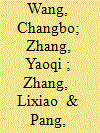

|
|
|
|
|
| Summary/Abstract |
Existing policies of household biogas projects focus mainly on supports on construction, but less consider management and maintenance, resulting in high scrap rate and waste of resources. Alternative policies must be explored to balance construction and operation. Taking the costs and benefits from a typical rural household biogas project, this paper assesses the economic performance at three different subsidy levels, i.e., no subsidy, existing standard and positive externality based standard. Furthermore three subsidy alternatives, one-time, annual and combined option are applied to the externality based standard. The results show that household biogas digesters have unsatisfactory economic performance without any subsidy and even in current subsidy policies. Environmental benefits of the digester were estimated as 2732 Chinese Yuan, significantly larger than existing subsidy standard. To keep continuous work during the 20-year lifespans of digesters, the income disparity of farmers among regions must be considered for policy application. With the increasing of labor costs, the ratio of initial subsidies must be reduced. These results provide policy implications to the future development of biogas projects in terms of both their construction and follow-up management, reuse of the abandoned digesters as well as the exploitation of other emerging renewable energy projects.
|
|
|
|
|
|
|
|
|
|
|
|
|
|
|
|
| 5 |
ID:
166929
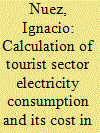

|
|
|
|
|
| Summary/Abstract |
The Canary Islands is a European archipelago whose principal economic activity is international tourism. Due to its geographic isolation, it does not have any connection with continental electricity grids. The Spanish state subsidises the extra cost of electrical energy generation in isolated systems. The purpose of this study is to quantify the proportion of the electricity bill that corresponds to tourist activity that is being subsidised. With this aim, three complementary methodologies have been developed. These tools could also be used in similar environments. The results reveal an average tourist sector consumption in the study years (2014–2017) between 12.8% and 16.5% of the total amount of electricity generated in the archipelago, with a monetary value of Spanish state subsidy estimated in €143.5 M in the year 2014. Additionally, a calculation was made of the values of CO2 emissions due to tourist electricity consumption for the years of the study period, with an estimated peak of 1.1 MtCO2 in 2017. From the point of view of energy policy, these results could be used to justify the adoption of various types of compensatory measures, including ecotaxes to be paid by the tourist visitor.
|
|
|
|
|
|
|
|
|
|
|
|
|
|
|
|
| 6 |
ID:
176707
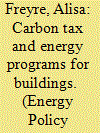

|
|
|
|
|
| Summary/Abstract |
Carbon tax is among the most intensively discussed topics in energy research and policy nowadays, but the question of using carbon tax revenue for environmental and energy policy purposes has received little attention so far. Currently the revenue generated from carbon tax has different usage in the countries worldwide, with only one quarter used for environmental and sustainable energy purposes. Against this background we study whether it can be advisable to use carbon tax revenue for financing energy efficiency and renewable energy (EERE) programs. Based on the case study of Switzerland, we demonstrate that such a policy approach could not only allow to achieve additional reduction of CO2 emissions, but also considerable net benefits to household sector with regard to reduction of heating costs, while having rather low program costs for individual households.
|
|
|
|
|
|
|
|
|
|
|
|
|
|
|
|
| 7 |
ID:
114562
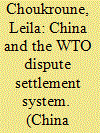

|
|
|
|
|
| Publication |
2012.
|
| Summary/Abstract |
Since its accession to the WTO on 11 December 2001, China has been involved in eight cases as complainant, 23 as respondent, and 89 as a third party. Against all pre-entry predictions, the China-related cases have not overburdened the WTO dispute settlement system, as if all parties were implicitly respecting a latent period before engaging in commercial hostilities. Often portrayed as a "passive rule taker" in the immediate aftermath of its accession, China was not only learning by attentively watching other members' strategies, but also benefiting from the benevolent attitude of its main trading partners, the US and the EU. Moreover, its participation in 89 WTO disputes as third party is not a trivial detail nor is it a sign of passivity, but rather one of cautious preparation that corresponded to the time needed to properly apprehend its new legal tools and all rights thereunder.
While there are many ways of approaching such an already vast body of decisions and related legal and economic literature, this article tries to reflect the uniqueness of the Chinese trade regime and the impact of such a peculiar mix between economic libreralisation and maintenance of the state on other WTO Members in addressing the following questions: the transitional product-specific safeguard measures adopted in reaction to a market disruption caused by Chinese imports, the antidumping and countervailing duties issue, and the restrictions on exportations or importations imposed by China for economic, but also societal and political reasons.
|
|
|
|
|
|
|
|
|
|
|
|
|
|
|
|
| 8 |
ID:
171369
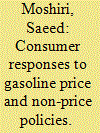

|
|
|
|
|
| Summary/Abstract |
Gasoline consumption in emerging economies have been rising rapidly due to economic growth and increasing urbanization rate in recent years. However, the development has brought about new socio-economic and environmental challenges leading governments to adopt various policies to control the trend. Although the impacts of price changes on gasoline consumption are well-researched in the literature, studies on different policies in a specific country is limited. In this paper, we investigate the impact of three distinct policies (price reform, rationing, and fuel-efficiency) on consumer responses in Iran. We estimate price, income, and efficiency elasticities across household characteristics, income groups, and provinces using the AIDS model and the household expenditures data for the period 2005–2016. The results show that the average price elasticity is -76, however, it varies across household characteristics, time, and space. The price responses are greater in provinces neighbouring the countries with high price differentials and welfare losses of price reform are more sever for lower income families. The estimated elasticities under different policy regimes show that energy price reform has led to significantly higher elasticities, while rationing has led to decreased elasticities. The more stringent efficiency regulation and increasing imports of fuel-efficient cars have also increased elasticities.
|
|
|
|
|
|
|
|
|
|
|
|
|
|
|
|
| 9 |
ID:
150823
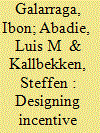

|
|
|
|
|
| Summary/Abstract |
The energy-efficiency gap has been high on research and policy agendas for several decades. Incentive schemes such as subsidies, taxes and bonus-malus schemes are widely used to promote energy-efficient appliances. Most research, however, considers instruments in isolation, and only rarely in the context of political constraints on instrument use, or for alternative policy goals. This paper presents a methodology for the optimal design of incentive schemes based on the minimisation of Dead Weight Loss for different policy goals and policy restrictions. The use of the methodology is illustrated by designing optimal combinations of taxes and subsidies in Spain for three types of appliance: dishwashers, refrigerators and washing machines. The optimal policies are designed subject to different policy goals such as achieving a fixed reduction in emissions or a certain increased market share for efficient appliances, and for policy constraints such as budget neutrality. The methodology developed here can also be used to evaluate past and current incentive schemes.
|
|
|
|
|
|
|
|
|
|
|
|
|
|
|
|
| 10 |
ID:
162930


|
|
|
|
|
| Summary/Abstract |
Energy and heat cross-subsidies are common in developing and transitioning countries, but the distributional and efficiency impacts of these policies (and reform) are largely unknown. In Post-Soviet countries such as Belarus, revenues from an industrial tariff on electricity are used to cross-subsidize heating for households. We analyze the distributional impacts of cross-subsidy reform with both input output methods and a calibrated static computable general equilibrium (CGE) model with heterogeneous households based on a household consumption survey. On average, GDP gains of roughly a quarter of a percent are computed across model runs which reduce taxes and subsidies from cross-subsidization. Reducing household heating subsidy rates equally across income groups is found to be regressive. Poorer households are overly-burdened due to higher heating expenditures while richer households enjoy gains from cheaper market prices for goods. The GDP gains are even larger when the tax rates are structured to create a distributionally-neutral reform.
|
|
|
|
|
|
|
|
|
|
|
|
|
|
|
|
| 11 |
ID:
150374
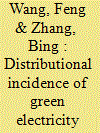

|
|
|
|
|
| Summary/Abstract |
Distributional incidences are fundamental to environmental and energy policies, a condition that has led to controversies on the equity of environmental and energy policy. Using data from China's Urban Household Income and Expenditure Survey data from 2007, this study quantified the distributional effects of the green electricity price subsidy policy among Chinese urban household and compared its effects by using lifetime income and annual income to classify households, respectively. The results show that total electricity subsidies are mainly driven by indirect electricity subsidies. By using lifetime income to classify households, subsidies to households in the poorest two groups accounted for less than 10.2% of the total subsidies, whereas money distributed to households in the top two deciles reached 35.4%. The comparison using annual income to group households also demonstrated the similar impact of the green electricity price subsidy policy. China’s future market reforms should allow electricity prices to reflect pollution abatement costs. Additionally, a multi-step block electricity price schedule can reduce the regressivity of the policy.
|
|
|
|
|
|
|
|
|
|
|
|
|
|
|
|
| 12 |
ID:
150911


|
|
|
|
|
| Summary/Abstract |
A majority of grid-connected households in South Africa use electricity for cooking and heating tasks. This thermal intensive use of electricity has a high load factor and is a contributory factor of electricity demand outstripping supply at peak demand periods. The government has promoted liquefied petroleum gas (LPG) as an alternative thermal energy source for household cooking and heating. This study evaluates the long-term successes, challenges and social impacts of an LPG intervention project that was piloted in Atteridgeville Township, a typical low-income suburb. The data was gathered through one-on-one household interviews with a sample of the beneficiaries. The results indicate that seven years after the LPG intervention, about 70% of the beneficiaries continue to use LPG and report that the intervention has improved their welfare. Fast cooking is cited as the key tangible benefit of LPG technology in households, followed by saving on electricity bills. The project would have achieved more success through better community engagement, including strict beneficiary selection criteria; a long-term LPG distribution and maintenance plan; and inclusion of recurring monthly LPG subsidies for indigent households. The study discusses the subset of factors necessary for successful rollouts of similar energy projects.
|
|
|
|
|
|
|
|
|
|
|
|
|
|
|
|
| 13 |
ID:
177208


|
|
|
|
|
| Summary/Abstract |
Given its limited oil and gas resources compared to its neighbours, energy diversification has been Oman’s stated goal since at least the 1980s. Yet, this paper argues that, due to the country’s structure of power generation, both issues of economic diversification and energy security are intimately linked and cannot be dissociated. Oman’s national policy for the energy sector, the political and economic challenges of the energy subsidy reforms implemented since the mid-2010s and the energy priorities as highlighted in the new long-term “Oman Vision 2040” national strategy are examined here. This paper also shows that the energy debate has played a critical role in the shaping of Oman’s foreign policy towards its Gulf Cooperation Council (GCC) counterparts, Iran and India, out of a desire to keep Oman’s –– more symbolic than real –– independence in working out its energy needs.
|
|
|
|
|
|
|
|
|
|
|
|
|
|
|
|
| 14 |
ID:
149953
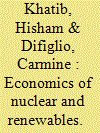

|
|
|
|
|
| Summary/Abstract |
This paper provides an assessment of the economic challenges faced by both nuclear power and “new” renewable electricity technologies. The assessment reflects the need to incorporate new renewables into power grids and issues faced in dispatching power and their effect on traditional electricity technologies as well as the need for transmission extension and/or grid reinforcement.
|
|
|
|
|
|
|
|
|
|
|
|
|
|
|
|
| 15 |
ID:
162947
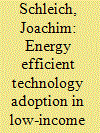

|
|
|
|
|
| Summary/Abstract |
This paper studies the adoption of high-cost, medium-cost, and low-cost energy efficient technologies (EETs) by income categories in eight European Union countries, relying on demographically representative household surveys carried out simultaneously among about 15,000 households in France, Germany, Italy, Poland, Romania, Spain, Sweden, and the United Kingdom. The statistical-econometric analyses allow the effects of income to differ by income quartiles in each country. For high cost EETs such as retrofit measures, the findings suggest that homeowners falling into the lowest income quartile exhibit lower adoption propensities than those falling into the highest income quartile. These findings provide some support for policies targeting “poor homeowners”, particularly in lower-income countries with a high share of owner-occupiers such as Poland and Romania. Further, differences in adoption propensities across income quartiles also exist for medium- and low-cost EETs such as appliances and light bulbs. Finally, analyzing factors related to homeowners receiving financial support for retrofit measures from governments or utilities suggests that differences in implementation rates between the highest and lowest income quartile would likely have been higher without such support schemes in place. For the United Kingdom (but not for other countries) these schemes appeared to have had a progressive effect.
|
|
|
|
|
|
|
|
|
|
|
|
|
|
|
|
| 16 |
ID:
150432


|
|
|
|
|
| Summary/Abstract |
Road transport is one of the sectors with highest energy consumptions in the planet, with large dependence of fossil fuels, and contribution for global greenhouse gas emissions. Although, Latin America is not a high-energy consumer, its share in global consumption is expected to grow, especially in the transportation sector. This make essential for developing countries the adoption of better policies to identify the vehicle groups with largest fuel demands. The present study describes the VKT technique to disaggregate road transport energy consumption by vehicle type, applied to the road transportation system of Ecuador. It also describes the procedures performed to estimate the variables required to run the model, and some of the practical applications that be used to create public policies. Results show as the biggest fuel consumers the heavy-duty freight cargo, followed by light duty vehicles. The estimation of greenhouse gas emissions evidence that road transport released 14.3 million tons of CO2 in 2012. When fuel consumption is compared by it costs, it can be confirmed that Ecuadorean Government covered, through subsidies, for 68% of the annual fuel costs of national road transport, demonstrating the importance of restructuring these expenditures in order to achieve an efficient road transport system.
|
|
|
|
|
|
|
|
|
|
|
|
|
|
|
|
| 17 |
ID:
183127


|
|
|
|
|
| Summary/Abstract |
This paper surveys normative and positive arguments on why oil and gas exporting countries, in particular OPEC members, may expand into downstream industries (e.g. refining, petrochemicals), instead of exporting raw materials. Indeed, local refining can serve as a partial hedge against the vagaries of the oil price. Furthermore, as downstream activities require more complex tasks, the potential to provide economy wide spillovers, thereby fostering overall economic development will be generated. Major explanations including price differentiation (e.g., export taxes), industrial organization (e.g., property rights), efficiency (e.g., vertical integration), local development and spillover effects (e.g., on comparative advantage), risk hedging, climate change, and finally, political economy (e.g., lobbying and empire building) are surveyed from normative and positive aspects, which are then tested against facts. We also highlight the fact that all of those justifications are only efficient if political considerations are put aside. Policies such as granting the national oil companies a monopoly and by very large subsidies on refined products may indeed hinder achieving some of those goals.
|
|
|
|
|
|
|
|
|
|
|
|
|
|
|
|
| 18 |
ID:
185685


|
|
|
|
|
| Summary/Abstract |
Supporting the adoption of zero-emission vehicle (ZEVs), including plug-in electric vehicles (EVs), has become a priority for governments due to their ability to reduce petroleum demand, improve air quality, and reduce carbon dioxide (CO2) emissions. Optimal strategies to accelerate EV adoption must weigh the relative value of alternative policy mechanisms to consumers, including public charging infrastructure and vehicle purchase subsidies. We use a historically validated light-duty vehicle consumer choice tool, the ADOPT model, to simulate personal light-duty vehicle adoption and related emissions in California. ADOPT is updated to incorporate a quantification of the tangible value of public charging infrastructure, allowing us to simulate the impact of investments in public charging infrastructure and vehicle purchase subsidies under different scenarios. We show that both policies result in increased EV adoption, with the most effective policy varying depending on vehicle technology assumptions. Under conservative technology improvement assumptions, infrastructure investments are most effective in promoting EV sales and reducing CO2 emissions, while under optimistic technology improvement assumptions a combination of infrastructure and subsidies best supports EV sales and CO2 emission reductions.
|
|
|
|
|
|
|
|
|
|
|
|
|
|
|
|
| 19 |
ID:
103330


|
|
|
|
|
| Publication |
2011.
|
| Summary/Abstract |
This paper constructs panel data from an 11-year data set on all 47 prefectures of Japan, covering the period 1996-2006 . We use this data set to analyze the factors affecting photovoltaic (PV) system diffusion. Our empirical results show that the regional government policy clearly helps to promote PV system adoption. It is also found that installation costs have a significant negative effect on PV system adoption, whereas housing investment and environmental awareness among residents have a positive effect. We believe that this finding has a significant implication for further PV system diffusion because it suggests the importance of regional diffusion policies reflecting the environmental awareness of regional residents.
|
|
|
|
|
|
|
|
|
|
|
|
|
|
|
|
| 20 |
ID:
126967


|
|
|
|
|
| Publication |
2013.
|
| Summary/Abstract |
Although China's use of the WTO dispute settlement system has increased, its legal actions remain less aggressive than those of other large economies. This article examines how China's subsidy policies make Chinese leaders reluctant to use WTO dispute settlement mechanisms in resolving trade disputes with other countries.
|
|
|
|
|
|
|
|
|
|
|
|
|
|
|
|
|
|
|
|
|